



New Zealand Sea Lion Threat Management Plan (NZSL TMP) - One year highlights -
- v i s i o n N Z S L T M P “promote the recovery and ensure the long-term viability of New Zealand sea lions, with the ultimate goal of achieving ‘Not Threatened’ status” 2
- o b j e c t i v e s N Z S L T M P 1. Halt the decline of the New Zealand sea lion population within 5 years . 2. Ensure the New Zealand sea lion population is stable or increasing within 20 years , with the ultimate goal of achieving ‘Not Threatened’ status. 3
N Z S L T M P - M ā t a u r a n g a m ā o r i “Under the NZSL TMP Ngāi Tahu will be active in the management and decision making in relation to the enhancement of the species, to ensure the flax-roots knowledge and the Ngāi Tahu voice is heard.” 4
N Z S L T M P - w o r k s t r e a m s Engagement Evaluation Direct Targeted mitigation research 5
N Z S L T M P - w o r k s t r e a m s 2nd Forum and Advisory Group meetings Communication: media, social Murihiku media, sea lions website… Otago Rakiura A Rāpoka Community Liaison role within DOC Engagement 6
N Z S L T M P - w o r k s t r e a m s Engagement Evaluation Direct Targeted mitigation research 7
N Z S L T M P - w o r k s t r e a m s Direct mitigation ‘Planks for Pups’ programme at the Auckland Islands is maintained and expanded upon Develop a strategy to reduce pup mortality from natural holes at Campbell Island Establish a Technical Advisory Group to review the SQU6T Operational Plan 8 Gareth Hopkins
N Z S L T M P - w o r k s t r e a m s Engagement Evaluation Direct Targeted mitigation research 9
N Z S L T M P - w o r k s t r e a m s Targeted • Complete second season of disease research research programme on the Auckland Islands • • Female sea lion nutritional stress and diet Review of the potential impacts of aquaculture studies on sea lions, with relevance to Port Pegasus sea lion ecology • Research into the demographic parameters for at-risk marine mammals as identified by the marine mammal risk assessment (sea lions) • Analysis of New Zealand sea lion tracking data to estimate overlap with fisheries 10
N Z S L T M P - w o r k s t r e a m s Engagement Evaluation Direct Targeted mitigation research 11
N Z S L T M P - w o r k s t r e a m s 2017/2018 Monitoring, including tagging, pup counts and tag re-sights, will occur at: o Auckland Islands o Campbell Island/Motu Ihupuku o South Island/Te Waipounamu o Stewart Island/Rakiura Evaluation 12
N Z S L T M P - m e a s u r e s Southland and Otago Rakiura 2017/2018 2,598 pups 2014/2015 2,316 pups Auckland Islands Campbell Island 13
Auckland Islands: pup numbers continue to increase from the 2014 count Demographic parameters such as adult female survival rate and pup survival rate improve Pup numbers consistently above 1,575 (the 2014 pup count), and ideally over 1,965 (the 2017 pup count) 2017 2018 2022 2019 2020 2021 14
Campbell Island/Motu Ihupuku: reduce pup mortality and support population growth Increased frequency and consistency of monitoring the population Pup counts at or above 696 (the 2015 pup count) Pup mortality rates are consistently lower than 40% per annum 2017 2018 2022 2019 2020 2021 15
Stewart Island/Rakiura: support population growth to achieve breeding colony status Pup counts remain at a number higher than 35 for 5 years in a row: a new breeding colony Continued increase in number of pups born to enable colonial breeding behaviour No deliberate human-cause mortality (eg shootings) Increased public interest and involvement in the conservation of sea lions 2017 2018 2019 2020 2021 2022 16
South Island/Te Waipounamu: facilitate population growth Pup counts increase above 16 (the 2017 pup count) per year along the Otago and Southland coastline, with an increased number of breeding sites No deliberate human-cause mortality (eg shootings) Increased public interest and involvement in the conservation of sea lions 2017 2018 2022 2019 2020 2021 17
Kia ora!! Enrique Pardo Department of Conservation Technical Advisor and NZSL TMP coordinator epardo@doc.govt.nz 18 A. Sriram
Recommend
More recommend